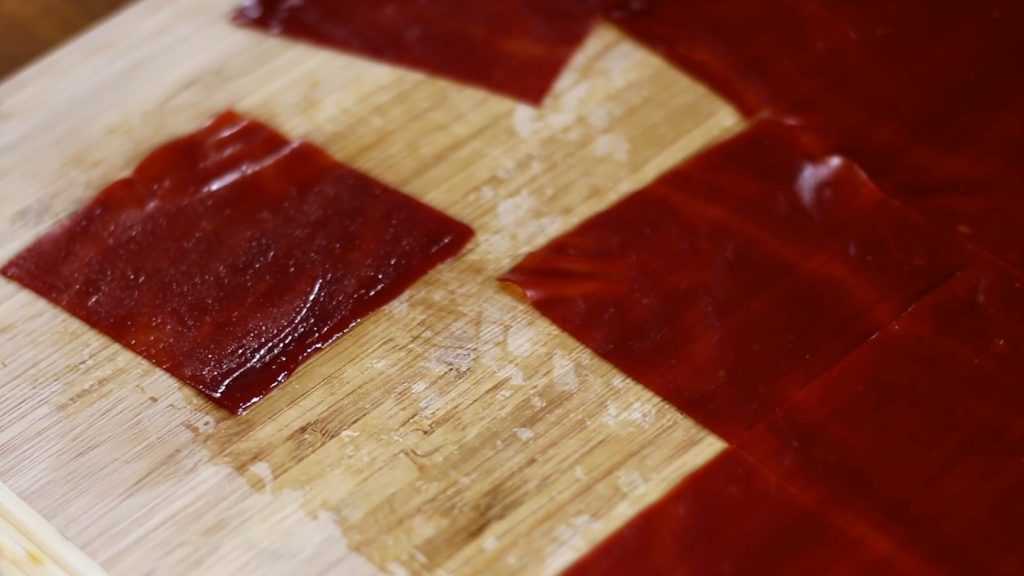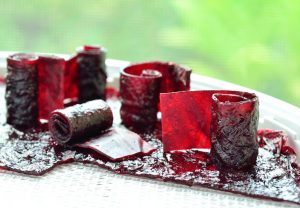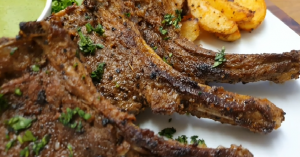Transform your typical condiment into a gourmet experience with this ketchup leather. It's a simple yet innovative way to add a burst of flavor to your favorite dishes. Perfect for topping burgers, breakfast sandwiches, or even meatloaf, this recipe offers a fun twist on the classic ketchup.

Photos of Ketchup Leather Recipe
The ingredients for this recipe are quite common, but if you don't usually keep dried basil or garlic powder in your pantry, make sure to add them to your grocery list. These seasonings add a depth of flavor that elevates the ketchup leather.
Ingredients for ketchup leather recipe
Tomato ketchup: The base ingredient for our ketchup leather, providing the familiar tangy and sweet flavor.
Dried basil: Adds a touch of herbaceous aroma and flavor.
Garlic powder: Imparts a subtle garlicky note that complements the tang of the ketchup.
Nonstick cooking spray: Ensures that the ketchup leather does not stick to the baking dish.
One reader, Esdras Daly says:





This ketchup leather recipe is a game-changer! It adds a unique, tangy twist to burgers and sandwiches. The texture is perfect, and it's so easy to make. Highly recommend trying it out!
Essential Techniques for Making Ketchup Leather
How to preheat the oven: Set your oven to 180 degrees Fahrenheit and allow it to reach the desired temperature before placing the dish inside.
How to lightly grease a baking dish: Use nonstick cooking spray to coat the surface of the baking dish lightly, ensuring an even layer to prevent sticking.
How to mix ingredients: Combine the ketchup, dried basil, and garlic powder in a medium bowl, stirring until well blended.
How to spread an even layer: Pour the ketchup mixture into the prepared baking dish and use a spatula to spread it evenly across the surface.
How to dehydrate in the oven: Bake the mixture at a low temperature for an extended period (3 hours) until it is fully dehydrated and no shiny spots remain.
How to cool completely: Allow the baked ketchup leather to cool entirely before attempting to remove it from the dish.
How to loosen edges with a knife: Run a knife around the edges of the cooled ketchup leather to separate it from the sides of the baking dish.
How to peel from the dish: Carefully lift a corner of the ketchup leather and slowly peel it away from the bottom of the dish.
How to cut into squares: Transfer the peeled ketchup leather to a cutting board and cut it into six even squares, discarding any scraps.
How To Make Ketchup Leather
This no-mess ketchup leather works just like a fruit roll up, but for your burgers and other savory meals! It’s made easy with just four ingredients.
Serves:
Ingredients
- nonstick cooking spray,for greasing
- ¾cuptomato ketchup
- 1tspdried basil
- ½tspgarlic powder
Instructions
-
Preheat the oven to 180 degrees F.
-
Lightly grease a 9 x 13-inch baking dish with nonstick spray.
-
In a medium bowl, mix together the ketchup, dried basil, and garlic powder.
-
Transfer the ketchup mixture to the prepared baking dish, then spread it in an even layer.
-
Bake for 3 hours, or until the ketchup is dehydrated with no shiny spots.
-
Remove from the oven, then let cool completely.
-
Run a knife around the edges of the ketchup leather to loosen from the baking dish.
-
Lift up a corner of the ketchup leather, then slowly peel from the bottom of the dish.
-
Transfer to a cutting board. Cut the ketchup leather into 6 even squares, discarding any scraps.
-
Serve on top of a burger or breakfast sandwich, or over meatloaf, and enjoy!
Nutrition
- Calories: 52.05kcal
- Fat: 0.54g
- Saturated Fat: 0.04g
- Monounsaturated Fat: 0.32g
- Polyunsaturated Fat: 0.16g
- Carbohydrates: 12.82g
- Fiber: 0.24g
- Sugar: 9.58g
- Protein: 0.57g
- Sodium: 408.88mg
- Calcium: 10.98mg
- Potassium: 135.68mg
- Iron: 0.34mg
- Vitamin A: 11.76µg
- Vitamin C: 1.85mg
Crucial Technique Tips for Perfect Ketchup Leather
When spreading the ketchup mixture in the baking dish, use an offset spatula to ensure an even layer. This will help the ketchup leather dehydrate uniformly, preventing any spots from being too thick or too thin.
Time-Saving Tips for Making Ketchup Leather
Prepare ingredients in advance: Measure out the ketchup, dried basil, and garlic powder ahead of time to streamline the mixing process.
Use parchment paper: Line the baking dish with parchment paper instead of using nonstick spray to make peeling the ketchup leather easier and faster.
Utilize a food dehydrator: If you have a food dehydrator, use it to speed up the dehydration process instead of baking for 3 hours.
Batch cooking: Make multiple batches at once and store them for future use to save time on repeated preparations.
Substitute Ingredients For Ketchup Leather Recipe
nonstick cooking spray - Substitute with parchment paper: Parchment paper can prevent sticking without adding any additional fat or calories.
nonstick cooking spray - Substitute with olive oil: Olive oil can be brushed lightly to prevent sticking and adds a subtle flavor.
¾ cup tomato ketchup - Substitute with tomato paste: Tomato paste can be thinned with a bit of vinegar and sweetened to mimic the consistency and taste of ketchup.
¾ cup tomato ketchup - Substitute with barbecue sauce: Barbecue sauce can provide a similar texture with a different, smoky flavor profile.
1 tsp dried basil - Substitute with dried oregano: Dried oregano offers a similar earthy flavor that complements tomato-based recipes.
1 tsp dried basil - Substitute with Italian seasoning: Italian seasoning contains basil along with other herbs, providing a well-rounded flavor.
½ tsp garlic powder - Substitute with fresh garlic: Fresh garlic can be minced and used in a slightly larger quantity to provide a more robust garlic flavor.
½ tsp garlic powder - Substitute with onion powder: Onion powder can add a similar depth of flavor if garlic is not available.
Creative Ways to Present Ketchup Leather
Serve smaller portion sizes: Cut the ketchup leather into elegant, bite-sized squares to ensure a refined presentation.
Use decoration: Garnish each piece of ketchup leather with a delicate sprig of fresh basil and a light dusting of garlic powder for visual appeal and aromatic enhancement.
Layer flavors: Place the ketchup leather atop a perfectly seared mini burger patty, adding a slice of aged cheddar and a thin slice of heirloom tomato to create a harmonious blend of flavors.
Add texture: Serve the ketchup leather on a toasted brioche bun with a light spread of truffle aioli to introduce a luxurious texture contrast.
Highlight freshness: Accompany the dish with a side of microgreens lightly dressed in lemon vinaigrette to add a burst of freshness and color to the plate.
Elevate presentation: Arrange the components on a sleek, white porcelain plate, using a balsamic reduction drizzle to create an artistic design that frames the ketchup leather and its accompaniments.
Storing and Freezing Ketchup Leather for Later Use
- Once the ketchup leather has cooled completely, you can store it in an airtight container or resealable plastic bag at room temperature for up to 1 week.
- To keep the ketchup leather fresh and pliable for a longer period, store it in the refrigerator for up to 2 weeks.
- If you want to store the ketchup leather for an extended time, follow these steps for freezing:
- Cut the ketchup leather into your desired shapes or sizes.
- Place a piece of parchment paper or wax paper between each piece of ketchup leather to prevent them from sticking together.
- Transfer the stacked ketchup leather pieces to a freezer-safe container or resealable plastic bag.
- Remove as much air as possible from the container or bag before sealing to prevent freezer burn.
- Label the container or bag with the date and store it in the freezer for up to 3 months.
- To thaw frozen ketchup leather, remove the desired amount from the freezer and let it thaw at room temperature for about 10-15 minutes, or until it becomes pliable again.
- Avoid refreezing previously frozen ketchup leather, as this may affect its texture and quality.
Surprising Facts About Ketchup Leather
A fun fact about this ketchup leather recipe is that it can be a great way to add a concentrated burst of tomato flavor to your dishes without the mess of traditional ketchup. This method of dehydration preserves the ketchup's taste while making it easy to store and use in various recipes.
Is Making Ketchup Leather at Home Cost-Effective?
This ketchup leather recipe is quite cost-effective for a household. With basic ingredients like tomato ketchup, dried basil, and garlic powder, the total cost is minimal. The approximate cost for a household of 4 people is around $2.50. Considering the unique twist it adds to dishes like burgers and meatloaf, the overall verdict rating is a solid 8 out of 10.
Is Ketchup Leather Healthy or Unhealthy?
The ketchup leather recipe, while creative and potentially tasty, is not particularly healthy. Here's why:
- High in sugar: Ketchup is known for its high sugar content, and this recipe uses a significant amount of it. Consuming excessive amounts of sugar can lead to various health issues, such as obesity, diabetes, and heart disease.
- Lacks nutritional value: The recipe primarily consists of ketchup, which offers little in terms of essential nutrients like vitamins, minerals, or fiber. The added dried basil and garlic powder provide some flavor but do not significantly improve the nutritional profile.
- Processed ingredients: Ketchup is a processed food item that often contains additives and preservatives, which may not be beneficial for overall health when consumed in large quantities.
To make this recipe healthier, consider the following suggestions:
- Opt for a low-sugar or sugar-free ketchup to reduce the overall sugar content of the recipe. You can also look for ketchup brands that use natural sweeteners like stevia or monk fruit extract.
- Incorporate more nutrient-dense ingredients into the recipe. For example, you could blend the ketchup with cooked vegetables like carrots, bell peppers, or spinach to boost the vitamin and fiber content. This will also add interesting flavors and colors to the ketchup leather.
- Experiment with homemade ketchup recipes that use fresh, whole ingredients. By making your own ketchup, you can control the amount of sugar and salt added and avoid any unwanted additives or preservatives.
- Serve the ketchup leather as a small garnish or condiment rather than a main component of the dish. This way, you can enjoy the unique texture and flavor without consuming excessive amounts of sugar or processed ingredients.
Editor's Opinion on the Ketchup Leather Recipe
This ketchup leather recipe is an innovative twist on a classic condiment, perfect for adding a concentrated burst of flavor to various dishes. The use of dried basil and garlic powder enhances the depth of the ketchup, making it more aromatic and savory. The low and slow baking process ensures a chewy texture that can elevate burgers, breakfast sandwiches, or meatloaf. However, the recipe could benefit from a touch of sweetness, perhaps a bit of honey or brown sugar, to balance the acidity of the ketchup. Overall, it's a clever and versatile addition to any culinary repertoire.
Enhance Your Ketchup Leather Recipe with These Unique Side Dishes:
Delicious Alternatives to Ketchup Leather
Why trust this Ketchup Leather Recipe:
This ketchup leather recipe is a game-changer for your culinary creations. By using simple ingredients like tomato ketchup, dried basil, and garlic powder, it offers a unique twist to traditional condiments. The slow baking process at a low temperature ensures the perfect texture, making it an ideal addition to burgers, breakfast sandwiches, or meatloaf. Trust this recipe for its simplicity, creativity, and the delightful burst of flavor it brings to your dishes.
Was this page helpful?
Have your own special recipe to share? Submit Your Recipe Today!











